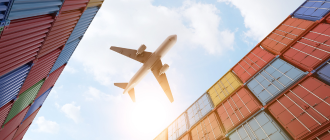
Air Freight Trends 2026: How Asia Pacific Is Redefining Global Trade
By FedEx | November 7, 2025
Air freight trends for 2026 point to a new era of global trade. From Asia-Europe trade growth to air freight sustainability, Asia Pacific is taking the lead. Here’s what you should know to stay ahead.
- Trade realignments are redrawing flight paths, with Asia-Europe and intra-Asia trade corridors posting consecutive months of growth.
- E-commerce is transforming freight demand, as bulk air shipments help businesses replenish inventory and meet customer expectations for speed.
- Air freight sustainability is moving from aspiration to action, with efforts to cut overall emissions in both air and ground operations.
Air freight – which, at FedEx, refers to heavy shipments of 68kg or more – has long been one of the fastest and most reliable ways to connect global markets.
It accounts for about 70% of the air cargo market, transporting largely time-sensitive and high-value goods such as electronics, pharmaceuticals, and automotive components. In 2024, global air freight volumes reached over 65 million tons, up 6% year over year. By 2035, freight tonnage is expected to rise to 98 million tons, driven by e-commerce, express delivery services, and global trade expansion.
From new flight routes to greener operations, the future of air cargo is taking shape right here in APAC. At FedEx, our vantage point across major trade lanes gives us a front-row seat to these shifts, and we’re committed to helping businesses seize them.
Here are the latest trends that are transforming the air freight industry.
1. Trade realignments are redrawing flight paths
Global trade is in flux. Geopolitical and tariff shifts are reshaping cargo flows, and aircraft are being redeployed to match this new reality.
Air cargo volumes, including air freight, have increased across several major trade corridors. Asia-Europe and intra-Asia trade lanes posted robust double-digit growth in September 2025 – a clear indication that regional corridors are powering ahead.
The Asia-Europe trade lane, for one, grew 12.4% year over year to capture more than a fifth of the industry’s market share. Not far behind is the intra-Asia trade lane, which grew 10% year over year and achieved 23 consecutive months of growth.
APAC leads the air freight market, accounting for around 40% of total freight volume, followed by North America at 25% and Europe at 20%. These figures underscore what we see on the ground: APAC is at the center of a new trade map, where businesses can diversify markets and mitigate risk through air connectivity.
To keep pace, air cargo operators are adding new flight paths. FedEx, for instance, has just launched five new weekly flights from China to Paris, France. We’ve also enhanced our intra-Asia network with improved services between our APAC hub in Guangzhou and cities like Penang and Bangkok.
This enhanced flight network enables APAC businesses to seize opportunities in the intra-Asia and Asia-Europe trade lanes.
2. E-commerce is transforming air freight demand
When most people think of e-commerce shipping, they picture parcels heading to customers. But behind the scenes, the real driver of demand is bulk freight. E-commerce giants and fast-growing brands rely on fast air freight solutions (such as FedEx International Priority Freight, which delivers shipments in one to three business days) to move inventory between factories, hubs, and warehouses – ensuring product availability and agility during surges in demand.
This backend efficiency – moving stock quickly through the supply chain – directly enables fast, reliable delivery of customer orders. Online shoppers today have high expectations for speed, with many looking for next-day delivery in domestic markets, and three- to seven-day delivery for international orders. Meeting this demand depends on efficient supply chains, and, increasingly, that means using air freight to keep products stocked and fulfillment centers ready.
The scale of this trend is staggering. In 2025, global e-commerce sales are set to reach USD 6.9 trillion, with APAC driving more than half of this growth. As a primary driver of air freight growth across APAC, e-commerce is fueling demand for cross-border express shipments from China, Hong Kong, and Southeast Asia. In fact, e-commerce shipments accounted for more than 50% of trans-Pacific air freight shipments in 2024, highlighting the growing influence of online retail on global air freight.
3. Air freight sustainability is moving from aspiration to action
Like every industry, air freight activities impact the environment and contribute to climate change. The challenge is finding the right balance between speed – one of the core advantages of air freight – and sustainability. Encouragingly, progress in this area is accelerating.
The International Air Transport Association (IATA), for example, has committed to achieving net-zero carbon emissions by 2050, and anticipates that sustainable aviation fuel (SAF) will deliver about 65% of the emissions reductions required to reach this goal. Airlines are also stepping up, with 81 carriers announcing 170 SAF agreements since 2013.
At FedEx, we have recently purchased more than three million gallons of blended SAF from Neste for use by our aircraft at Los Angeles International Airport (LAX). With this one-year purchase, we became the largest US cargo airline to deploy SAF at LAX.
But fuel isn’t the only frontier. Freight-specific innovations are also transforming air and ground operations. For instance, freight aircraft are constantly being modernized for higher capacity and lower fuel burn. Logistics providers like FedEx are similarly working towards updating their fleets with more fuel-efficient aircraft to reduce overall emissions.
At FedEx Australia, we’ve also introduced innovations such as the Dynamic Drive-Through Pallet Dimensioning System, which automates the measuring and weighing of palletized freight. By providing precise dimensions and weights, this solution enables us to optimize space and load planning to carry more cargo per trip – resulting in fewer trips and reduced fuel consumption.
A new era for air freight
These air freight trends point to a transforming industry. Shifting trade routes, e-commerce growth, and air freight sustainability are driving a more agile, forward-looking global trade ecosystem, with APAC at its core.
Opportunities favor those who move quickly, and FedEx is ready to help businesses stay ahead by enabling cross-border expansion, building more resilient supply chains, and advancing green logistics.
***
SHARE THIS STORY
- 85% Of APAC Businesses Plan To Expand Into Europe, According To New FedEx Report
- Generative AI: A New Frontier
- How To Ship A Giant Panda
- The Rise Of Intra-Asia Trade: Opportunities In The China-Southeast Asia Corridor
- Where Do Old Planes Go When They Retire?
- What’s So Dangerous About Coconuts? Your Guide To Dangerous Goods Logistics
Sign up now and save on your shipping rates!
Sign up now and earn discounts by shipping instantly with FedEx Ship ManagerTM at fedex.com.
Recommended For You

Air Freight Vs Sea Freight: What’s Right For Your Business?
Learn how to choose between air freight and sea freight for international shipping, with tips for SMEs on cost, speed, reliability, and more.
Read More
85% Of APAC Businesses Plan To Expand Into Europe, According To New FedEx Report
Download FedEx’s new Asia-Europe Trade Report to uncover the latest market trends and opportunities shaping cross-border growth.
Read More
Why Global Brands Should Look East: The Case For Expanding Into APAC
Asia Pacific is where growth happens. Expanding your business to APAC connects you to rising consumer demand and cross-border trade.
Read More

